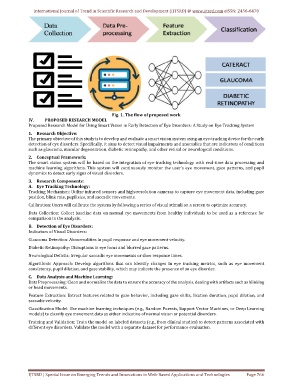Page 776 - Emerging Trends and Innovations in Web-Based Applications and Technologies
P. 776
International Journal of Trend in Scientific Research and Development (IJTSRD) @ www.ijtsrd.com eISSN: 2456-6470
Fig. 1. The flow of proposed work
IV. PROPOSED RESEARCH MODEL
Proposed Research Model for Using Smart Vision in Early Detection of Eye Disorders: A Study on Eye Tracking System
1. Research Objective:
The primary objective of this study is to develop and evaluate a smart vision system using an eye-tracking device for the early
detection of eye disorders. Specifically, it aims to detect visual impairments and anomalies that are indicators of conditions
such as glaucoma, macular degeneration, diabetic retinopathy, and other retinal or neurological conditions.
2. Conceptual Framework:
The smart vision system will be based on the integration of eye-tracking technology with real-time data processing and
machine learning algorithms. This system will continuously monitor the user's eye movement, gaze patterns, and pupil
dynamics to detect early signs of visual disorders.
3. Research Components:
A. Eye Tracking Technology:
Tracking Mechanism: Utilize infrared sensors and high-resolution cameras to capture eye movement data, including gaze
position, blink rate, pupil size, and saccadic movements.
Calibration: Users will calibrate the system by following a series of visual stimuli on a screen to optimize accuracy.
Data Collection: Collect baseline data on normal eye movements from healthy individuals to be used as a reference for
comparison in the analysis.
B. Detection of Eye Disorders:
Indicators of Visual Disorders:
Glaucoma Detection: Abnormalities in pupil response and eye movement velocity.
Diabetic Retinopathy: Disruptions in eye focus and blurred gaze patterns.
Neurological Deficits: Irregular saccadic eye movements or slow response times.
Algorithmic Approach: Develop algorithms that can identify changes in eye tracking metrics, such as eye movement
consistency, pupil dilation, and gaze stability, which may indicate the presence of an eye disorder.
C. Data Analysis and Machine Learning:
Data Preprocessing: Clean and normalize the data to ensure the accuracy of the analysis, dealing with artifacts such as blinking
or head movements.
Feature Extraction: Extract features related to gaze behavior, including gaze shifts, fixation duration, pupil dilation, and
saccadic velocity.
Classification Model: Use machine learning techniques (e.g., Random Forests, Support Vector Machines, or Deep Learning
models) to classify eye movement data as either indicative of normal vision or potential disorders.
Training and Validation: Train the model on labeled datasets (e.g., from clinical studies) to detect patterns associated with
different eye disorders. Validate the model with a separate dataset for performance evaluation.
IJTSRD | Special Issue on Emerging Trends and Innovations in Web-Based Applications and Technologies Page 766

